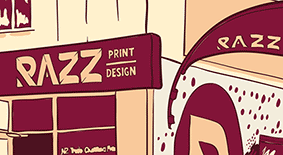For the most part, Canva is designed to produce digital graphics for things like social media or websites.
However, more and more people are using it to design for print. Here are some tips to help you get a print-ready file.
Canva TIPS
Make Your Document the Correct Size Before You Start
If you are not using Canva Pro, you can NOT re-size your design later. We have a page that gives you the different sizes of common and economical sizes to design to. (We can print other custom sizes too, but the standard sizes are the most efficient cut sizes to make the best use of the sheets of paper that you can use in New Zealand.)
Include Bleed
It’s very important to make sure that you have added ‘bleed’ as well. (It’s also so important that we have a whole page to describe it.) Simply, it’s extra printing beyond the desired cut-size that is trimmed off after printing to allow a design to be ‘printed to the edge of a sheet’.
Specifically, for Canva, you will either need to pull ALL images and objects WAY off the side of your page and then select “Crop marks and Bleed” when downloading a ‘print pdf’. This seems confusing since Canva doesn’t let you see the part of the image that is off the page and doesn’t show you how far these need to be extended beyond the edge. We suggest make the document (from the start) to be the correct size plus 3mm on each edge. (This will add 6mm to the height and width.)
Use High-Quality Graphics and Photos
Our printers are very good at their job but if you have supplied a poor-quality or damaged photo, there is nothing that they can do to fix it. Unfortunately, they will print it exactly as supplied so if you have supplied something that isn’t very great, you could be disappointed.
After placing a image, scaling it larger usually means a reduction in quality and sometimes if you scale an ordinary photo down it can sometimes improve it a bit.
Graphic with enough pixels
Graphic with a lower resolution
RGB vs CMYK
Should your images be RGB or CMYK? For print, CMYK is better for accuracy but on our smaller-run machines, it actually doesn’t matter much. Each of our image processors will convert an RGB image in the best way for the particular printer.
If you are planning to get a large print-run, you may need to get in touch with us first. Generally, you may need to keep in mind the RGB has a larger colour range than CMYK. What this means is if you have a design that has a very bright green or blue that looks great on a screen, you need to be prepared for a muted colours when printed on paper.
Proofread and Double-Check!
Checking your spelling and things like phone numbers before you send us a ‘print-ready’ file can save you money by avoiding a reprint. Sometimes, opening up your pdf and ‘zooming in’ can help you tell if your photos and text is clear enough too.
It’s Okay to Ask
If you supply a pdf, and it is not print-ready, it will need to be fixed. You will either have the opportunity to fix it yourself and then re-supply a new pdf or get us to fix it for a fee. Even if it’s not 100%, getting in touch with us to help you provide the best possible pdf, will keep your printing within budget.



